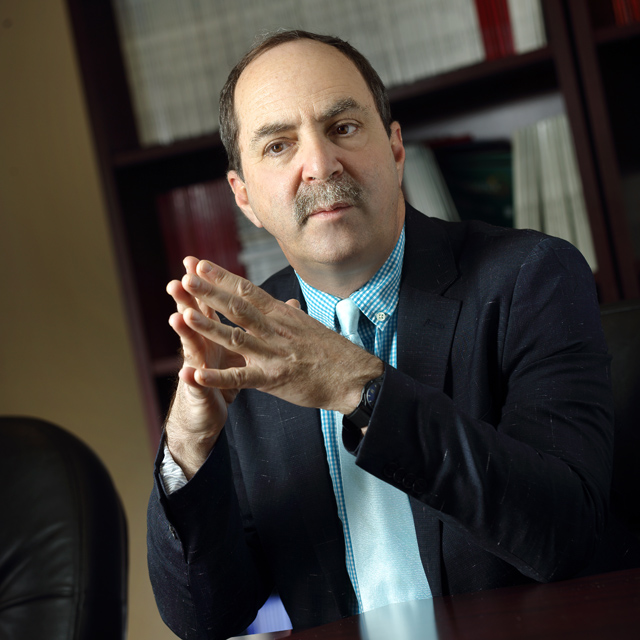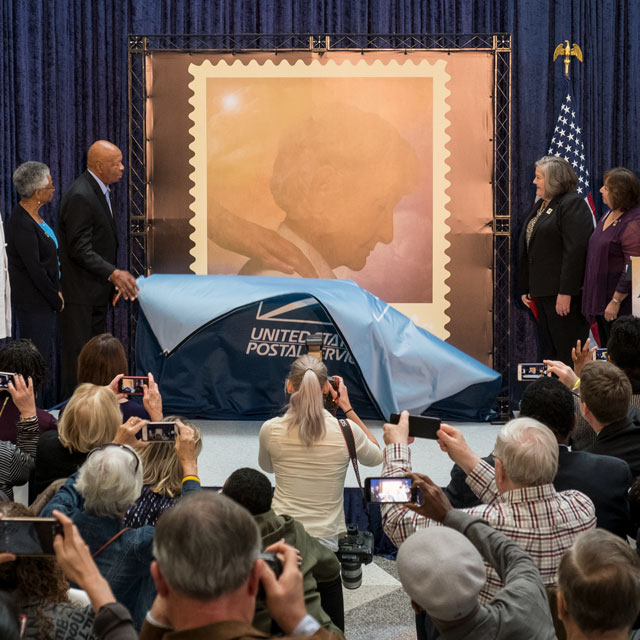Barbara Alden listens carefully to Constantine Lyketsos, trying her best to answer his questions. The first one is easy. Her favorite fruit is banana, she tells the director of the Johns Hopkins Memory and Alzheimer’s Treatment Center.
But her second favorite fruit? She can’t remember. Her husband, John, reminds her that it’s blackberries, but a few minutes later she’s forgotten again. “Peaches?” she guesses.
Alden, 75, was diagnosed with Alzheimer’s disease in 2012. Escalating forgetfulness had forced her to retire from her career in finance, and she had turned to the Johns Hopkins center, hoping to learn her symptoms were simply a byproduct of aging.
No such luck. At the center, she took tests that indicated she had trouble remembering what she had just learned — a warning sign for Alzheimer’s. Then, a PET scan of her brain confirmed the diagnosis when it found the amyloid proteins that characterize the disease.
John describes that moment as a “catastrophic emotional bolt that went through my head and my heart.”
Accompanied by John, Barbara now returns to the center every six months for evaluations and care. During a recent visit, nurse Brandi Saddler gave her a Mini Mental State Exam to assess the disease’s progress. The test, which involved drawing shapes, writing a sentence and following directions, showed no cognitive decline since the previous visit.
However, notes John, Barbara’s functional decline continues. She can no longer navigate daily activities such as grocery shopping or choosing a weather-appropriate outfit on her own.
John, also 75, has been getting forgetful too. In 2015, Lyketsos diagnosed him with mild cognitive impairment, often a first sign of Alzheimer’s disease. He goes to the memory center twice a year for cognitive assessments similar to Barbara’s.
Memory and Alzheimer’s Treatment Center
With no cure and an average life span of 10 years after diagnosis, Alzheimer’s disease is devastating. People with Alzheimer’s struggle to accept and plan for the inexorable loss of their most precious assets — the thoughts, memories, relationships and personality traits that define who they are.
The Memory and Alzheimer’s Treatment Center, founded in 2008, combines psychiatry, neurology and geriatric medicine to educate, treat and support patients and caregivers. They help patients maximize quality of life by improving functionality, managing symptoms and treating co-morbidities.
The center logs about 3,000 appointments per year, with about 30 percent coming from out of state, says Esther Oh, associate professor of medicine, assistant professor of pathology and associate director of the center.
Services include a resource center, an annual caregiver conference called Journey to Hope, and a Memory Café with outings and activities for patients and caregivers. The center also has a young-onset Alzheimer’s clinic, for patients younger than 65.
The Aldens, guided by clinicians at the memory center, moved from their waterfront home in Annapolis to Ginger Cove, a continuing care facility, also in Annapolis, that allows them to receive more care over time.
“We understand that dementia care is more than a pill,” says Oh.
Johns Hopkins Researchers Search for Improved Treatments
In fact, efforts to develop pills to prevent or treat this devastating condition have been frustrating. Almost a hundred therapies have been tested, yet the few medications currently on the market can only ease behavior and cognition symptoms, not cure the disease or reverse its progress.
Alzheimer’s disease is the most common cause of dementia, accounting for about 70 percent of cases and afflicting some 5.7 million Americans. Because the population is aging, by 2050 that number could reach 14 million, says the Alzheimer’s Association.
One piece of good news is that the federal government, recognizing the psychic and financial toll of Alzheimer’s disease, has more than quadrupled research funding since 2011, to $2.3 billion in 2019, according to the Alzheimer’s Association.
The Johns Hopkins Alzheimer’s Disease Research Center has been leading efforts to find improved treatments for the disease since it was first funded in 1984. It now provides infrastructure support to more than 150 investigators throughout the institution, says Marilyn Albert, the center’s director.
These research efforts, and others around the world, provide crucial information about what happens in the brain when Alzheimer’s disease is developing.
Alzheimer’s disease occurs when proteins known as beta amyloids form plaques outside nerve cells in the brain, while another protein, called tau, forms tangles inside the nerve cells. Together, these plaques and tangles block the signals between nerves, thwarting thoughts and memories. Over time, the brain’s nerve cells and tissue die, and the brain shrinks.
One of the key hopes for the future is earlier detection of the disease, says Albert. Indirect measures of the brain, using biomarkers such as amyloid imaging and cerebrospinal fluid, are providing clues to which cognitively normal individuals are likely to develop symptoms in five to seven years.
Measurement of biomarkers in cognitively normal individuals has led to another insight: Some patients with the neuron-clogging amyloid and tau proteins don’t show symptoms for decades, while others experience forgetfulness and mood changes in the earliest stages of disease. And as many as half of people who develop dementia show mood and personality symptoms before the onset of memory symptoms.
“This has enormous implications for treatment,” says Albert, noting that doctors may eventually be able to slow or halt the disease in its earliest stages.
It is also clear that Alzheimer’s disease varies by individual. For example, says Lyketsos, some versions of Alzheimer’s disease might respond to anti-inflammation therapies, while others do not.
He says a new Johns Hopkins Precision Medicine Center of Excellence in Alzheimer’s Disease brings together clinicians and researchers from across the institution to better understand the disease’s subsets and develop treatments accordingly.
Building Cognitive Reserve
Researchers believe people who don’t show symptoms right away have cognitive reserves — a greater supply of neural connections, which allow brains to better create “workarounds” when some of those connections are blocked.
“If you have two 80-year-olds, one with an eighth grade education and a cognitively undemanding job, and the other with an advanced degree and a challenging job, the same amount of amyloid will have different effects,” says Jason Brandt, professor of psychiatry and neurology, who has been studying dementia at Johns Hopkins for decades.
To help brains stay strong, he says, “We encourage exercise, good nutrition, social interaction and cognitive activity.”
The Aldens follow this advice. “We always walk a mile or swim in the morning,” says John. “We eat yogurt and fruit for breakfast, and a main meal of salad with chicken or fish. In the evening, we listen to music. We find our favorite musicians on YouTube and sometimes just sit together and listen for two or three hours. We see our children and grandchildren. These are things we enjoy doing, and they are also medically recommended.”
Caring for the Caregivers
Still, caring for Barbara takes a toll on John. “I’m on duty whenever she’s awake,” he says. Perpetually concerned for her safety, he says, “We stick close together whenever we are out of the apartment. Some of my most anxious moments are when she’s in the women’s restroom at a public venue. I lurk outside the door, waiting for her to come out.”
Even in its early phases, the disease can make people stubborn, irritable or agitated. John has noticed these changes in his wife.
“I’m seeing more anxiety,” he says. “It’s subtle. She’ll say, ‘Why are you with me in my closet suggesting outfits?’ Or if we’re in a restaurant, she’ll ask why I’m ordering for her.”
Clinicians at the Memory and Alzheimer’s Treatment Center urge caregivers like John to carve out time for themselves and seek therapy to help develop coping strategies. John says he’ll follow their advice — just not yet.
“Our life together is going to get harder,” he acknowledges.


